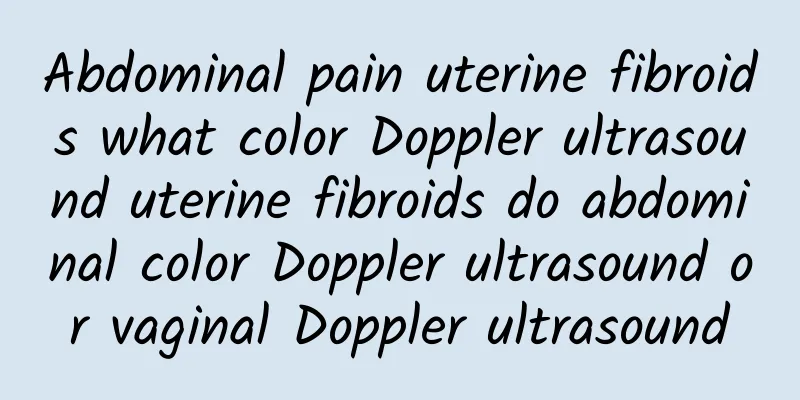What are the symptoms of adnexitis?

|
What are the symptoms of adnexitis? Nowadays, the rampant gynecological diseases seriously endanger the health of women. Adnexitis is one of them. Among the female internal reproductive organs, the fallopian tubes and ovaries are called adnexae. As the name suggests, adnexitis refers to the inflammation of the fallopian tubes and ovaries. So, what are the symptoms of adnexitis? Let's learn about it together. 1. Acute adnexitis. The main symptom is acute lower abdominal pain, accompanied by fever. During gynecological examination, there is obvious tenderness and rebound pain in the adnexal area. Routine blood tests can show an increase in white blood cell count and a significant increase in the proportion of neutrophils. If acute adnexitis is not treated in time or is not treated thoroughly, it can turn into chronic adnexitis. 2. Chronic adnexitis. Patients with chronic adnexitis are relatively common, and their symptoms are mainly manifested in the following aspects. 1. Abdominal pain of varying degrees. The patient experiences symptoms such as lower abdominal distension, pain, and lumbar pain, which may be mild or severe, accompanied by increased leucorrhea, back pain, menstrual disorders, etc., and often worsens during menstruation or after fatigue. 2. The appearance of a tender "lump". During gynecological examination, there is tenderness, thickening, or a tender mass in the bilateral or unilateral adnexal area, and the white blood cell count is elevated or normal. 3. Hydrosalpinx. Chronic inflammation of the fallopian tubes can lead to fibrosis, thickening and obstruction of the fallopian tubes over time, and can also cause adhesions with surrounding tissues. If both ends of the fallopian tubes are blocked, hydrosalpinx can form, and the accumulated water can penetrate into the ovaries that are adhered together, forming a fallopian tube cyst. Experts emphasize that if acute adnexitis is not treated in time, it can turn into chronic adnexitis, which has a great impact on the patient's normal life. If chronic adnexitis is not treated thoroughly, it can induce infertility or ectopic pregnancy. Therefore, once the disease occurs, you should go to a regular hospital for further examination and diagnosis in time. Clinically, the treatment of adnexitis is mainly divided into two types: drug conditioning and surgical treatment. Since each patient's condition is different, the treatment methods used are also different. Experts remind female friends to pay more attention to personal hygiene and eating habits, avoid sexual intercourse during menstruation, and seek medical attention as soon as possible if they find discomfort. |
<<: How is ultrasound diagnosis of uterine fibroids performed?
>>: How to improve the cure rate of threatened abortion
Recommend
Misunderstandings in the Treatment of Uterine Fibroids
Studies have shown that the abuse of surgery is e...
Women should pay attention to the 7 major reasons that lead to amenorrhea
My period comes every month, which is really anno...
What medicine is better for patients with uterine fibroids? What foods should patients with uterine fibroids not eat?
What medicine is best for patients with uterine f...
Avocado plays 5 important roles in burning fat and fighting inflammation
Avocado is a delicious fruit, and you would never...
The dangers of pelvic inflammatory disease
Pelvic inflammatory disease is a common disease a...
Is cervical erosion with cysts serious? Serious enough to require prompt treatment
Many female friends are probably familiar with ce...
What tests should be done for recurrent miscarriage? These 4 types of tests should be done
If a woman has recurrent miscarriage, she should ...
When should a urinary catheter be inserted during interventional embolization for adenomyosis?
Adenomyosis interventional embolization usually r...
Leptin helps with weight loss! Is the lazy sleeping method really useful?
Can you lose weight while sleeping? In recent yea...
Common symptoms of irregular menstruation
Irregular menstruation is a symptom of women'...
Tailor-made for women! A comprehensive 28-day exercise guide for your menstrual cycle
Whether you have a long-term exercise habit or yo...
What are the precautions after abortion?
Things that need to be paid attention to after ab...
What are the dangers of multiple uterine fibroids? Will multiple uterine fibroids worsen the disease?
Multiple uterine fibroids grow very fast, or afte...
What are the typical symptoms of bacterial vaginosis?
What are the typical symptoms of bacterial vagino...
Causes of uterine fluid accumulation during pregnancy
Uterine effusion is also called intrauterine effu...









